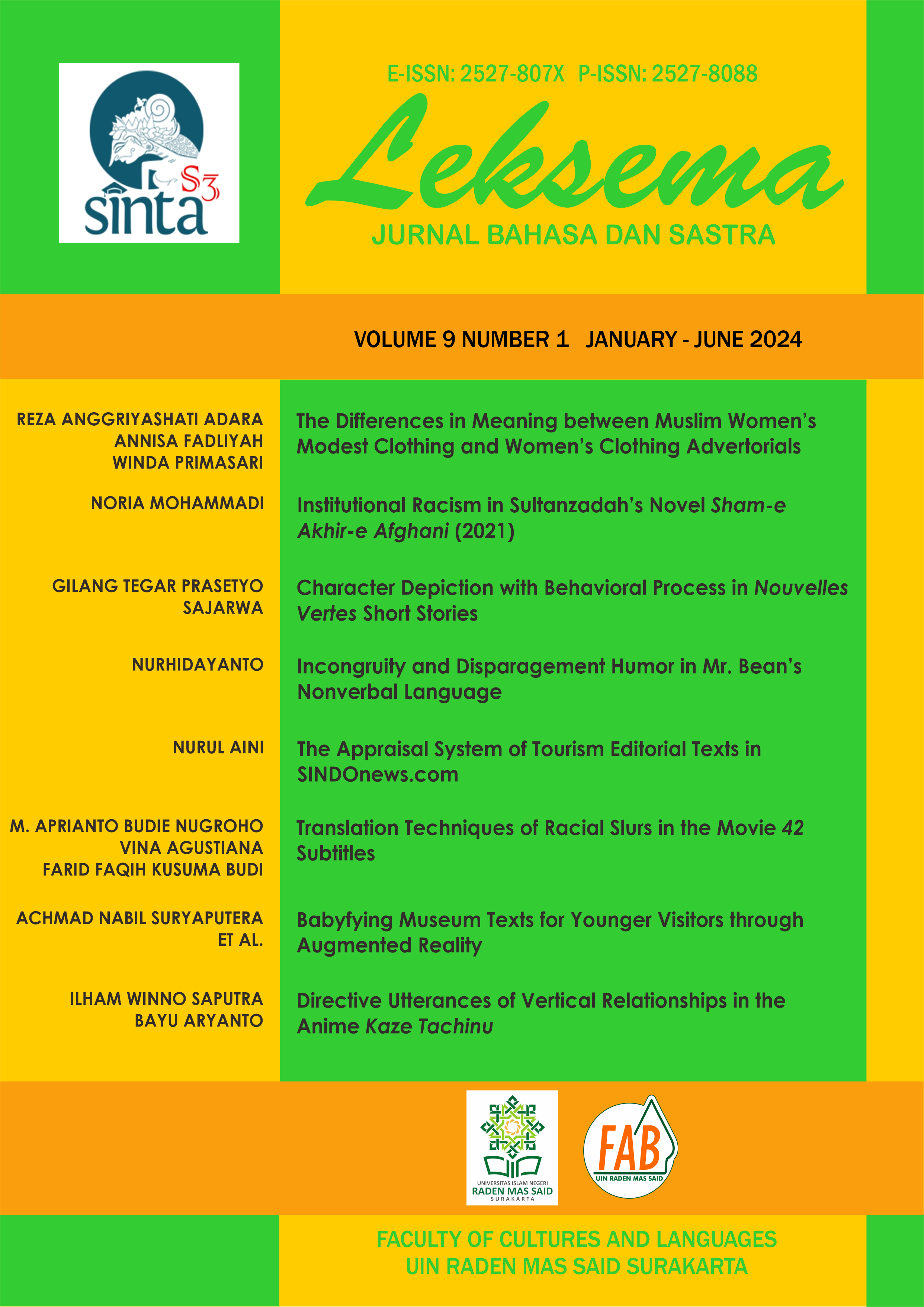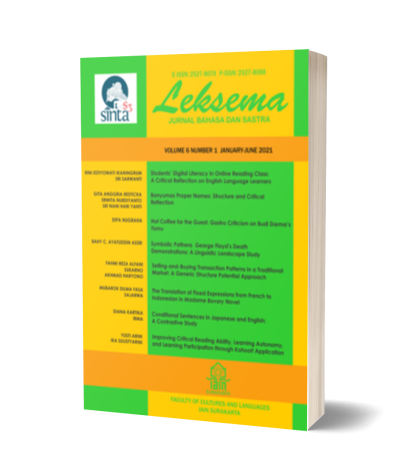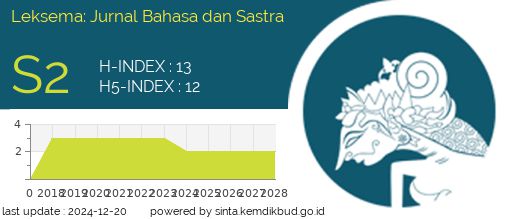DIRECTIVE UTTERANCES OF VERTICAL RELATIONSHIPS IN THE ANIME 'KAZE TACHINU'
DOI:
https://doi.org/10.22515/ljbs.v9i1.8931Keywords:
directive utterance, grammatical marker, sociopragmatic, vertical relationshipAbstract
This study aimed at describing the directive utterances as well as the grammatical markers of the utterances in the conversations with vertical relations in the anime entitled Kaze Tachinu. This study used Searle's (1979) theory of directive speech acts and employed a descriptive-qualitative method. It also utilized sociopragmatic approach as an additional perspective in the analysis. The result shows that various forms of directive utterances are spoken by characters who have higher social status towards the others from the lower ones. In total, there are 48 directive utterances found for both direct and indirect categories. Meirei (command) dominates with 40 utterances and is followed by irai (request) kinshi (prohibition), kanyuu (invitation) and adobaisu(advice), each of which has two utterances.
Downloads
References
Adnjani CH, Ghaisani, Mulyadi, and Diah Syafitri Handayani. 2023. “Directive Illocutionary Acts in Japanese Teen Movies Peach Girl and Miseinen Dakedo Kodomo Janai”. Leksema: Jurnal Bahasa dan Sastra 8 (1): 79-89. DOI:10.22515/ljbs.v8i1.6067.
Alfiansyah, Muhamad Alfin, Wahya, and Abu Sufyan. 2021. “Analisis Kesopanan Tindak Tutur Direktif dalam Pembelajaran Daring: Kajian Pragmatik”. Literasi: Jurnal Ilmiah Pendidikan Bahasa dan Sastra Indonesia 11 (2): 53-68. DOI:10.23969/literasi.v11i2.3412.
Arifiany, Nurinna, Maharani P Ratna, and Trahutami SI. 2016. “Pemaknaan Tindak Tutur Direktif dalam Komik Yowamushi Pedal Chapter 87-93”. Japanese Literature 2 (1): 1-11.
Aryanto, Bayu. 2020. “Characteristics of Directive Speech Acts in the Dissemination of COVID-19 Mitigation Information in Japan”. Japanese Research on Linguistics, Literature and Culture 3 (1): 13-26. DOI:10.33633/jr.v3i1.4424.
Astika, I Made, Diah Ayu Murtiningrum, and Ade Asih Susiari Tantri. 2021. “Analisis Tindak Tutur Ekspresif dalam Acara Mata Najwa: Perlawanan Mahasiswa.” Jurnal Pendidikan Bahasa dan Sastra Indonesia 11 (1): 55-66. DOI: https://doi.org/10.23887/jjpbs.v11i1.29366
Austin, John Langshaw. 1962. How to Do Things with Words. Oxford: Oxford University Press.
Hatsuda, Ayana. 2022. Advice Giving in Japanese Conversations Item Type Text (Electronic Dissertation). Tucson: The University of Arizona. http://rightsstatements.org/vocab/InC/ 1.0/.
Hidayat, Taufik Rahman and Nova Yulia. 2020. “Tindak Tutur Direktif Bahasa Jepang dalam Dialog Film Flying Colors (ビリギャル) Karya Sutradara Nobuhiro Doi”. Jurnal Bahasa dan Pembelajaran Bahasa Jepang 3 (2): 44-69. DOI:10.24036/omg.v3i2.189.
Iori, Isao, Kazunari Iwata, and Mori Atsuhi. 2010. “「やさしい日本語」を用いた公文書の書き換え.”
Khair, Hafizah El. 2021. “Directive Speech Acts in Howl’s Moving Castle by Hayao Miyazaki”. Proceedings of The Fifth International Conference on Language, Literature, Culture, and Education (ICOLLITE 2021). DOI:10.2991/assehr.k.211119.049.
Khotimah, Ari Khusnul and Nise Samudra Sasanti. 2019. “Analisis Penggunaan Aizuchi oleh Penutur Asing Bahasa Jepang dalam Video Youtube Mengenai Homestay di Jepang Episode 1-3”. Hikari: Jurnal Ilmiah Mahasiswa 3 (1): 1-2. https://ejournal.unesa.ac.id/index.php/hikari/article/view/27185.
Masamune, Mineko. 2000. “日本語の命令依頼表現について”. September.
McKay, Sandra Lee, and Nancy H. Hornberger (Eds.). 2009. Sociolinguistics and Language Teaching. Cambridge: Cambridge University Press. DOI: 10.1017/CBO9780511551185.
Muslihah. 2017. Tindak Tutur Direktif pada Drama Miss Pilot (Kajian Sosiopragmatik). (Thesis). Semarang: Universitas Diponegoro.
Nara, Yuri. 2022. “ミュージカル『オペラ座の怪人』の日本語訳における,” March.
Prakoso, Bima Mugi. 2020. Tindak Tutur Direktif Perintah dan Permintaan dalam Novel Bahasa Jepang (Kajian Pragmatik)日本語の小説における命令と依頼の指示発話行為 (Thesis)”. Semarang: Universitas Diponegoro.
Sarif S., Irzam, and Nani Darmayanti. 2020. “Tindak Tutur Bahasa Jepang pada Media Sosial Instagram di Masa Pandemi Covid-19: Suatu Kajian Pragmatik”. Metahumaniora 10 (3): 285-294.
Searle, John R. 1979. A Taxonomy of Illocutionary Acts. Minneapolis: University of Minnesota Press.
Sing Gao, Lyu. 2014. “役割語についての研究-ゲームの男性キャラクタの言葉遣いを中心として-.” Taipei: National Taiwan University.
Sutawikar, Elly and Pika Yestia Ginanjar. 2017. “Bentuk Vokatif dalam Dialog Wacana Bahasa Jepang.” The 1st International Conference on Language, Literature and Teaching.
Verawati, Fifin and Mulyadi. 2019. “Tindak Tutur Masyarakat di Desa Lawangan Daya Kecamatan Pademawu Kabupaten Pamekasan.” Ghancaran: Jurnal Pendidikan Bahasa dan Sastra Indonesia 1 (1): 41-51. DOI: 10.19105/ghancaran.v1i1.2984.
Weblio. 2024. https://www.weblio.jp/content/%E3%82%82%E3%81%AE.
Yule, George. 1996. Pragmatics. Oxford: Oxford University Press.
Yuliarti, Rustono, and Agus Nuryatin. 2016. “Tindak Tutur Direktif dalam Wacana Novel Trilogi Karya Agustinus Wibowo”. Seloka: Jurnal Pendidikan Bahasa dan Sastra Indonesia 4 (2): . DOI: 10.15294/seloka.v4i2.9864.
Downloads
Published
Issue
Section
License
Copyright (c) 2024 Leksema: Jurnal Bahasa dan Sastra

This work is licensed under a Creative Commons Attribution-NonCommercial-ShareAlike 4.0 International License.
The copyright of the received article shall be assigned to the publisher of the journal. The intended copyright includes the right to publish the article in various forms (including reprints). The journal maintains the publishing rights to published articles.
In line with the license, the authors and users (readers or other researchers) are allowed to share and adapt the material only for non-commercial purposes. In addition, the material must be given appropriate credit, provided with a link to the license, and indicated if changes were made. If authors remix, transform or build upon the material, authors must distribute their contributions under the same license as the original.







